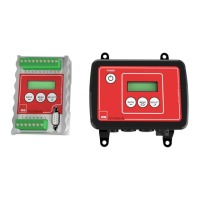AQ Elteknik AB Ultrasound Controller Manual 17
Echo and WR (Wall Reverberate) and there are three different Level Switches: Level Switch KS,
Level Switch LS and Level Switch RS.
Echo Technique
The echo-technique uses echo from a reflecting surface inside the container (usually the opposite
container wall) to determine if there is liquid or not inside. Level Switch KS or Level Switch LS can
be used but not Level Switch RS.
The echo-technique transmits short sounds and then measures the echo bouncing on the
reflecting surface. When there is an echo, there is liquid inside and with no liquid there is no echo.
The liquid must not attenuate the sound too much. Small bubbles and particles in the liquid can
cause attenuation and unmixed liquids having different sound velocities can cause refraction of
the sound and thereby wrong indication of low level. It is important that the sound-beam from the
sensor is reflected back to the sensor and not diverted in the wrong direction.
It is desirable that the ultrasound passes as easy as possible through the container wall. How well
it passes depend on the wall material and thickness. Steel or glass wall should be in the range
1,2mm - 15 mm and plastic wall <15mm (PP<10mm). Plastic with fiberglass can be troublesome.
Testing on the actual container is recommended. Any welding or other unevenness in the wall
should be avoided as it can refract (bend) the sound-beam in an unwanted direction.
The ultrasound beam behaves similar to a light-beam, the direction of the echo depend on from
what angle it hits the reflecting surface. Obstructing object in the path between sensor and the
reflecting surface should be avoided. The sound beam is approximately 1cm in diameter. A tube
in the center of the container can give an echo but it is weak. In case there are obstructing objects
inside the container, perhaps the Level Switch RS with the WR-technique is a better choice.
On small containers, disturbing background echoes becomes stronger in relation to the echo.
Level Switch LS and KS should therefore not be used on containers smaller than 44mm diameter.
WR Technique
The WR technique measures vibrations in the container wall to determine if there is liquid or not
behind the wall. Level Switch RS should be used (and on plastic walls Level Switch KS can also
be used)
The WR-technique transmits sound and then measures how quickly vibrations in the container
wall disappear. Vibrations in the wall disappear more quickly with liquid inside due to the
dampening effect of the liquid. The WR-technique works with most liquids since the sound does
not have to travel through the liquid. But the WR-technique is dependent on the material and
thickness of the wall. Steel or glass wall 1,2mm - 15 mm or plastic wall < 15mm (PP<10mm)
should be ok. Fiberglass-plastic could be troublesome and testing on the actual container is
recommended. WR technique has quite high temperature dependence, depending on wall
material, and should not be used if temperature differ more than 15ºC from temperature during
calibration.
On plastic walls it is also possible to use Level Switch KS with the WR-technique. Level Switch KS
can also be used with the WR-technique on a container with jacket to sense the presence of liquid
in the inner container (if the gap between the jacket and the container is filled with liquid).
The WR-technique measures very small signal changes and is sensitive to small movements of
the Level Switch. The Level Switch should therefore be glued with silicone. The WR-technique
can also be sensitive to liquid drops remaining on the inside of the wall and sensitive to
temperature changes. The advantage of the WR-technique is it is independent of liquid properties
and there is no need for a reflecting surface.

